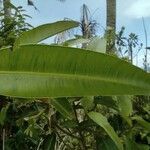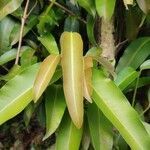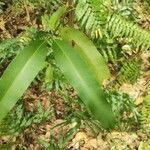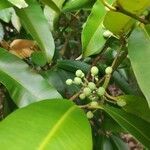Tree; twigs fine tomentulose. Leaves oblong or narrowly ovate, 10-20 cm long, 3-7 cm wide, apically short acuminate into a drip tip, basally obtuse, the costa elevated or plane above, elevated beneath to the tip, sparingly puberulent, lateral veins evident, ribs (veins plus ducts) 39-40 per cm, the margins mostly not drying revolute, petioles 1-1.5 cm long, drying dark, minutely tomentose, grooved above. Inflorescences short cymes fasciculate in the leaf axils, crowded, the peduncle basally pubescent, bracts wanting, bracteoles obsolete; pedicels ca. 1.5 cm long, glabrous, slender. Flowers perfect, sepals 2; petals 2(-3), ca. 8 mm long, rotund, apically ciliolate; stamens 60-100 (Stevens, 1976), the filaments ca. 3 mm long, basally connate, the anthers oblong, ca. 2 mm long; ovary glabrous, the style ca. 3 mm long, the stigma peltate. Fruit ovoid to globose, ca. 10 mm across, sometimes apiculate, drying brown, often glaucous, more or less smooth. This species is recognizable by the very numerous ribs of the leaves and by the small fruit.
More
Tree to 26 m high. Terminal bud sublinear, 4–20 mm long; uppermost axillary buds (0.5–) 2–5 mm long pointed, nearly always tightly adpressed to terminal bud. Twigs ±glabrous. Leaves; petiole 1.5–2 mm wide, puberulous; lamina ovate to elliptic, suboblong or subobovate rarely, (3.5–) 6.5–29 (–36) cm long, (1.5–) 2.4–10.2 cm wide, base cuneate, rounded (rarely) or cordate shallowly, apex acute to acuminate, rounded (rarely) or truncate and apiculate (rarely), midvein from above lamina base to midpoint raised with or without raised margins, glabrous above. Inflorescence axes glabrous, branched lateral branches ½ length of main axis or longer. Pedicel 6–28 mm long, up to 32 mm long in fruit, glabrous. Flowers 10–15 mm diam.; tepals 4, outer tepals ovate; stamens 40–140, 4–5 mm long, anther oblong, 0.7–2.5 (–3) mm long; style 1.5–3 mm long; stigma peltate. Fruit globose or subglobose; apex rounded, 9–16 (–25) mm long, 9–15 (–18) mm wide. Seeds subglobular with bumps.
A tree up to 26 m high. The stems have white to yellow latex. The trunk is 30-70 cm across. The leaves are opposite and simple. They are 7-29 cm long by 2-10 cm wide. The flowers are 1 cm across. They are white. There are 7-20 flowers in a cluster. The fruit are dark bluish black. They are 1 cm across.
Lowland or lower montane rain forest or sometimes in swamp forest at elevations up to 1,700 metres. Usually grows in small, well developed pockets of rain forest around soaks and springs in Australia.
More
A tropical plant. It grows in lowland rainforest. It occurs at 465 m altitude. It grows between sea level and 1220 m altitude. It does best in well drained places.
Grows in sandy loam soil, or on sandstone, in rainforest, perennially wet monsoon forest or evergreen notophyll vineforest.





